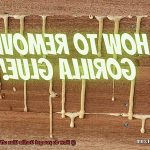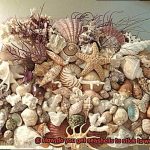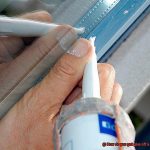Got Gorilla Glue gunking up your quartz countertop?
No worries, you’re not alone. Removing this stubborn adhesive from delicate surfaces like quartz can be a real headache.
In this guide, I’ll walk you through some foolproof methods to safely banish Gorilla Glue from your countertop.
So, grab your cleaning gear and let’s dive into the world of stress-free countertop cleaning.

What is Gorilla Glue?
Contents
- 1 What is Gorilla Glue?
- 2 How to Remove Excess Gorilla Glue from Quartz Countertop
- 3 Using Solvents to Dissolve Residue
- 4 Alternatives to Acetone and Isopropyl Alcohol
- 5 Testing Solvents on a Small Area First
- 6 Gently Rubbing the Residue with a Clean Cloth or Sponge
- 7 Repeating the Process for Stubborn Glue Residues
- 8 Thoroughly Cleaning the Quartz Countertop
- 9 Conclusion
When it comes to adhesive products, one name towers above the rest – Gorilla Glue. This formidable adhesive has earned a reputation for its exceptional bonding capabilities across a wide range of applications.
Whether you’re a DIY enthusiast or a skilled craftsman, Gorilla Glue is your go-to choice for securing and joining various materials. Let’s delve deeper into the extraordinary features that make Gorilla Glue an adhesive powerhouse.
Unyielding Strength and Durability:
Gorilla Glue is renowned for its ability to create an incredibly strong and durable bond. With its polyurethane-based formula, it securely adheres to materials like wood, stone, metal, ceramics, and more. This remarkable strength ensures that your projects remain intact even under heavy stress.
Versatility at Its Finest:
Versatility defines Gorilla Glue. It effortlessly bonds different surfaces together, making it suitable for countless applications. Whether you’re tackling construction projects, woodworking, or engaging in creative crafts, Gorilla Glue has got you covered.
Weatherproof and Temperature Resistant:
One standout feature of Gorilla Glue is its ability to withstand extreme conditions. Completely waterproof, it ensures that your bond remains intact even in wet environments. Additionally, this adhesive can handle a wide range of temperatures, making it suitable for both indoor and outdoor projects.
Expanding Nature for Enhanced Bonding:
Gorilla Glue’s unique expanding nature sets it apart from other adhesives. When exposed to moisture, this glue expands to fill gaps and create an even stronger bond between surfaces. This feature ensures that every nook and cranny is securely sealed.
Different Forms for Different Needs:
To cater to various project requirements, Gorilla Glue comes in different forms – liquid, gel, and tape. This versatility allows you to choose the most suitable form for your specific task, ensuring optimal results.
How to Remove Excess Gorilla Glue from Quartz Countertop
Accidents happen, and sometimes Gorilla Glue ends up on your beautiful quartz countertop. But don’t worry. With the right techniques, you can safely remove the excess glue and restore your countertop to its original shine. In this article, we’ll guide you through the process step-by-step, using common household items and a gentle touch.
Act Fast to Prevent Damage:
When it comes to removing excess Gorilla Glue from your quartz countertop, time is of the essence. The longer the glue sits, the harder it becomes to remove. So, don’t wait. Address the issue as soon as you notice it.
Scrape Away Dried Glue:
Start by gently scraping off any dried glue using a plastic scraper or putty knife. Be careful not to scratch the surface of your countertop as you do this. Remember, gentle pressure is key.
Try Acetone or Rubbing Alcohol:
If there are still traces of glue remaining, reach for acetone or rubbing alcohol. Apply a small amount to a clean cloth and gently rub it onto the affected area. Test it first in an inconspicuous spot to ensure it won’t cause damage or discoloration.
Use Warm Soapy Water:
For stubborn residue, mix warm water and dish soap, then soak a clean cloth in the soapy solution. Gently scrub the glue until it starts to loosen. Rinse the cloth frequently and continue scrubbing until all the glue is gone.
Specialized Adhesive Remover:
For larger areas or stubborn Gorilla Glue, you may need a specialized adhesive remover. Follow the instructions carefully and ensure proper ventilation. These products are designed to break down adhesives without harming your quartz countertop.
Clean and Dry Thoroughly:
After removing the glue, clean your countertop with a mild detergent or quartz cleaner. Use a non-abrasive cloth to wipe down the entire surface, ensuring all traces of adhesive and cleaning agents are removed. Rinse well and dry with a clean cloth.
Using Solvents to Dissolve Residue
Using Solvents to Dissolve Residue: A Guide to Removing Gorilla Glue from Your Quartz Countertop
Accidents happen, and sometimes that means ending up with stubborn Gorilla Glue residue on your beautiful quartz countertop. But fear not. In this comprehensive guide, we will walk you through the process of using solvents to dissolve that sticky mess and restore your countertop to its pristine condition.
First and foremost, it is crucial to select the right solvent for the job. Solvents are powerful chemicals capable of dissolving various substances, including adhesive residues like Gorilla Glue. In this particular case, acetone is highly recommended due to its effectiveness in removing adhesive residues.
However, before applying acetone directly onto your countertop, it is always prudent to conduct a patch test on a small, inconspicuous area. This step ensures that the solvent does not cause any damage or discoloration to the surface.
Once you have confirmed the safety of acetone on your countertop, it’s time to roll up your sleeves and get down to business. Grab a clean cloth or sponge and apply a small amount of acetone onto it.
Gently dab the Gorilla Glue residue, being careful not to vigorously rub the surface as this could potentially scratch the delicate quartz material. Allow the solvent to sit on the glue for a few minutes, granting it ample time to penetrate and soften the adhesive.
Now comes the exciting part – removing the softened glue. Armed with either a plastic scraper or your trusty fingernail, carefully scrape off the glue from the countertop. Take your time and exercise caution to avoid any accidental scratches or damage. If there are remnants of glue remaining, do not panic. Simply repeat the process until all traces of Gorilla Glue have vanished.
Once you have successfully eliminated every last bit of Gorilla Glue residue, it is essential to clean the area with mild soap and water. This step ensures the removal of any remaining solvent residue and leaves your countertop spotless. Afterward, take the time to thoroughly dry the countertop to prevent potential moisture damage.
Alternatives to Acetone and Isopropyl Alcohol
Sticky situations happen to the best of us, especially when it involves stubborn glue on a beautiful quartz countertop. While acetone and isopropyl alcohol are often recommended for glue removal, there are alternative methods and products that can safely and effectively tackle this challenge. So, if you’re searching for readily available options that won’t harm your countertop, keep reading.
Heat it Up:
Who would have thought that your trusty hairdryer or heat gun could save the day? By applying heat directly to the glued area, you can soften the adhesive bond. Start with low heat and gradually increase if needed, while keeping the heat source moving. Once the glue is softened, gently scrape it off with a plastic scraper or credit card.
Citrus-Based Adhesive Removers:
Nature has its own solution for adhesive removal. Look for adhesive removers containing natural citrus extracts or d-limonene as their active ingredient. Apply the remover to the Gorilla Glue, let it sit for a few minutes, and then gently scrape off the softened glue using a plastic scraper or credit card.
White Vinegar:
This kitchen staple does more than just dress salads. The acidic nature of white vinegar can help break down adhesive bonds. Soak a clean cloth or sponge in white vinegar and place it directly onto the affected area. After 15 minutes, gently scrub the softened glue with the cloth or sponge. Use a plastic scraper or credit card to remove any remaining residue.
Eco-Friendly Adhesive Removers:
For those who prioritize sustainability, eco-friendly adhesive removers are available. These products utilize plant-based solvents and oils that are biodegradable and won’t harm the environment or your quartz countertop. Look for certifications such as USDA Certified Biobased or Green Seal to ensure the product’s eco-friendliness.
Testing Solvents on a Small Area First
Finding a stubborn Gorilla Glue stain on your beautiful quartz countertop can be frustrating. But fear not. With the right approach and careful testing, you can safely remove that adhesive menace without causing any damage. In this guide, we’ll explore the importance of testing solvents on a small area first and provide you with step-by-step instructions to safely remove Gorilla Glue from your quartz countertop.
Why Test Solvents on a Small Area First?
Protecting the integrity of your countertop:
Quartz is known for its durability, but it’s not invincible. Using the wrong solvent or abrasive materials can cause permanent damage. By testing solvents on a small area first, you can ensure that the solution is safe and effective before applying it to the entire stain.
Assessing the solvent’s effectiveness:
Different solvents have varying chemical compositions and properties. By testing them on a small area, you can observe how they interact with the glue stain. If the solvent dissolves or softens the adhesive, it indicates that it may be effective in removing the glue.
Step-by-Step Guide to Testing Solvents:
Gather the necessary materials:
You’ll need a clean cloth or sponge, mild soap, warm water, a plastic scraper or credit card, and the solvents you intend to test (ensure they are safe for quartz surfaces and approved by the manufacturer).
Choose an inconspicuous spot:
Select a small area on the countertop that won’t be easily noticed if any damage occurs.
Apply the solvent:
Apply a small amount of solvent onto the glue stain and let it sit for a few minutes. Observe any changes in consistency or texture.
Gently scrub the area:
Using a soft cloth or sponge, gently scrub the area to see if the glue begins to loosen or come off. Avoid applying excessive pressure or using abrasive materials that could harm the quartz surface.
Assess the results:
If the solvent effectively removes the glue stain without causing any damage, you can proceed with confidence. However, if the solvent has no effect on the stain, try using warm water and mild soap along with gentle scrubbing to break down the glue.
Gently Rubbing the Residue with a Clean Cloth or Sponge
Dealing with sticky Gorilla Glue residue on your beautiful quartz countertop can be frustrating. However, fear not. By following a few simple steps and using the right technique, you can say goodbye to that adhesive mess and restore the pristine beauty of your countertop. In this guide, we will walk you through the process of gently rubbing away the residue with a clean cloth or sponge. Let’s get started.
Step 1: Gather Your Supplies
Before starting the removal process, gather the necessary supplies: a clean cloth or sponge, warm water, and optionally, a gentle dish soap or mild household cleaner.
Step 2: Prepare Your Cloth or Sponge
Ensure that your cloth or sponge is clean and free from abrasive particles that could scratch the quartz surface. Dampen it with warm water, making sure it is not soaking wet.
Step 3: Gently Rub in Circular Motions
Apply light pressure to the Gorilla Glue residue using the damp cloth or sponge. Start rubbing in circular motions, being careful not to scratch or damage the quartz surface. Be patient and persistent as it may take some time for the adhesive to break down.
Step 4: Reapply Warm Water if Needed
If the glue residue is stubborn, re-dampen your cloth or sponge with warm water as you work. This will help soften the glue further and make it easier to remove. Avoid oversaturating, as excess water could cause damage.
Step 5: Use Mild Dish Soap or Cleaner (if necessary)
For particularly stubborn areas, apply a small amount of gentle dish soap or mild household cleaner onto the cloth or sponge. This can provide extra cleaning power without harming the quartz surface. Rinse off any soap residue thoroughly with warm water after cleaning.
Step 6: Wipe and Dry
Once all traces of Gorilla Glue residue are gone, use a separate clean cloth or sponge to wipe down the countertop and remove any remaining moisture. Finish by drying the area completely with a soft, lint-free towel to prevent water spots or streaks.
Repeating the Process for Stubborn Glue Residues
You’ve tried everything in your arsenal to get rid of that stubborn glue residue on your quartz countertop, but it’s still hanging on like a limpet. Fear not, my friend, because we’ve got a few more tricks up our sleeves that will make that glue surrender.
First, let’s double down on heat. If you’ve already used a hairdryer or a heat gun to soften the glue, don’t give up just yet. Sometimes, a little extra heat can work wonders. Increase the temperature slightly and give it another shot. Just remember to maintain a safe distance from the surface to prevent any damage.
If the heat doesn’t do the trick, it’s time to supercharge with solvents. Look for adhesive removers or glue dissolvers specifically designed for tough adhesives. These powerful products can be found at your local hardware store or online. Follow the instructions carefully and let the solvent work its magic.
But what if that pesky residue is still clinging on? Well, it’s time to scrub-a-dub-dub. Grab your trusty plastic scraper or credit card once again, but this time, apply a little more pressure. Be gentle yet firm as you scrape away that stubborn glue residue. Remember, we want a pristine quartz surface without any scratches.
For those remnants that just won’t quit, let’s bring in the baking soda paste power. Create a thick paste by mixing baking soda with water. Apply this paste to the affected area and let it sit for a few minutes. Then, grab a soft cloth or sponge and give it a gentle scrub. Rinse thoroughly with water afterwards.
If you’ve repeated these steps and that glue is still holding on for dear life, it may be time to call in the pros. A quartz countertop specialist or professional cleaner will have the expertise and proper tools to tackle even the most stubborn glue residues without causing any harm to your precious surface.
Thoroughly Cleaning the Quartz Countertop
We’ve all been there – that moment when you accidentally spill some Gorilla Glue on your beautiful quartz countertop. Panic sets in as you frantically search for a solution to remove the sticky mess without causing any damage. Well, fear not. We’ve got you covered with our step-by-step guide on how to thoroughly clean your quartz countertop and bid farewell to that pesky Gorilla Glue.
Step 1: Gather your supplies
- Plastic scraper or spatula
- Rubbing alcohol
- Soft cloth or sponge
- Warm water
- Mild dish soap
- Non-abrasive cleaner specifically designed for quartz surfaces
Step 2: Let it dry
Patience is key. Ensure that the Gorilla Glue has fully dried and hardened on the countertop before attempting to remove it.
Step 3: Scrape it off
Gently scrape off any excess Gorilla Glue using a plastic scraper or spatula. Be cautious not to apply too much pressure, as this could scratch the surface of your quartz countertop.
Step 4: Soapy solution
Dampen a soft cloth or sponge with warm water and mild dish soap. Delicately scrub the affected area to remove any remaining residue from the Gorilla Glue. Remember to use gentle motions and avoid abrasive cleaners or scrub brushes that could potentially harm your countertop.
Step 5: Rubbing alcohol magic
Moisten a clean cloth or sponge with rubbing alcohol and gently rub the affected area in circular motions. The alcohol should help dissolve the glue without causing any harm to your quartz surface.
Step 6: Non-abrasive cleaner
For stubborn or dried-on Gorilla Glue, look for a non-abrasive cleaner specifically formulated for quartz surfaces. Follow the manufacturer’s instructions and use it in conjunction with warm water and a soft cloth or sponge to remove the glue.
Step 7: Rinse and dry
Once you’ve successfully removed the Gorilla Glue, rinse the countertop thoroughly with warm water to ensure all cleaning agents are removed. Dry the surface with a clean, lint-free cloth to avoid any streaks or water spots.
Remember, prevention is key. Use cutting boards, avoid placing hot objects directly on the surface, and clean up spills promptly to prevent any potential damage.
QYmZSDjLQ9A” >
Conclusion
Removing Gorilla Glue from a quartz countertop can be a challenging task, but with the right techniques and products, you can restore your countertop’s pristine condition. Here are some effective methods to tackle this sticky situation.
One option is to use acetone, a powerful solvent that can break down the adhesive properties of Gorilla Glue. Simply dampen a cloth or sponge with acetone and gently rub the affected area in circular motions. Be cautious not to scrub too vigorously, as it may damage the surface of the quartz countertop.
Another alternative is to use isopropyl alcohol, commonly known as rubbing alcohol. Apply a small amount of alcohol onto a clean cloth and dab it onto the glue residue. Allow it to sit for a few minutes to soften the glue before gently wiping it away.
For stubborn glue stains, you can try using a plastic scraper or an old credit card to carefully scrape off any excess adhesive. Take care not to scratch or gouge the quartz surface while doing so.
If all else fails, consider using a specialized adhesive remover specifically designed for removing tough adhesives like Gorilla Glue. These products are readily available at hardware stores and come with detailed instructions on how to safely apply them on your quartz countertop.
Remember, when dealing with any chemical substances or solvents, always follow safety precautions such as wearing protective gloves and ensuring proper ventilation in your workspace.
In conclusion, removing Gorilla Glue from a quartz countertop requires patience and careful handling.






